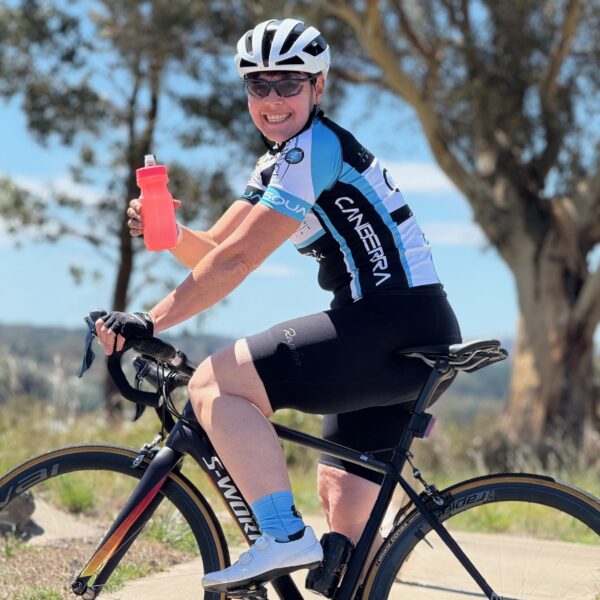Ride, Tri, and Thrive with Cheryl
Welcome to the second edition of Ride, Tri, and Thrive! As we dive into January, let’s take a moment to focus on some key training essentials: hydration, sun protection, and managing heat while training and racing. Whether you’re gearing up for your next triathlon or cycling adventure or simply aiming to thrive in your training routine, these tips will keep you performing at your best.
1. Summer Training Essentials
Summer training is all about staying safe and maximising performance in the heat. Focusing on hydration, sun protection, and heat management is important while maintaining a consistent, adaptable training routine. This ties directly into the key areas of focus:
- Hydration: Staying hydrated ensures you can perform at your best while avoiding fatigue and heat-related illnesses.
- Sun Protection: Protecting your skin from harmful UV rays reduces the risk of sunburn and skin damage, keeping you safe during outdoor training.
- Heat Management: Adapting your routine to manage high temperatures ensures you stay safe and comfortable while training in summer conditions.
Embrace these principles to set yourself up for success in 2025.
2. Hydration: More Than Just Water
Hydration is vital for optimal performance and recovery, especially during summer training. Proper hydration supports endurance, reduces fatigue, and maintains mental focus. To stay hydrated:
- Pre-Exercise: Begin well-hydrated by drinking 500-600ml of fluid 2-3 hours before exercise. Adjust based on body weight (5-7ml/kg) and add electrolytes to optimize hydration.
- During Exercise: Drink 400-800ml of fluid per hour, depending on sweat rates. Use electrolytes, including magnesium, to replace essential minerals lost through sweat and prevent cramping.
- Post-Exercise: Rehydrate with 1.5 times the fluid lost during activity. Fluids containing electrolytes and carbohydrates aid in recovery and improve fluid retention.
For a comprehensive hydration guide, see this resource.
3. Sun Protection: Guard Your Skin
Sun protection is essential for outdoor training, especially in summer. Prolonged UV exposure increases the risk of skin damage, sunburn, and windburn, which can harm performance and health. Cyclists are also known for their crisp tan lines. However, people do look at you strangely when they see the lines. Don’t forget to protect often-overlooked areas like the scalp under helmets (especially if you have thinning hair) and lips; nothing is worse than chapped lips or a burnt head.
- Use Broad-Spectrum Sunscreen: Choose SPF 30 or higher, apply it 20 minutes before training, and reapply every 2 hours.
- Protective Gear: Modern innovations like summer arm warmers provide sun protection without retaining heat. Use UV-protective clothing, sunglasses, and hats whenever practical.
- Don’t Overlook Small Areas: Remember to apply sunscreen to the scalp if you have thinning hair, and always use SPF lip balm to protect your lips.
For more tips on staying sun-safe, visit AIS Sun Safe Sports Position Statement.
4. Heat Management: Train Smart in Warm Conditions
Managing heat is critical for safe and effective training in summer. High temperatures increase the risk of dehydration and heat-related illnesses, but with smart strategies, you can train safely and perform at your best:
- Acclimatize Gradually: To help your body adapt, start with shorter sessions in the heat and gradually increase intensity over 1-2 weeks. Heat training has been shown to enhance cardiovascular efficiency and performance in hot and temperate conditions.
- Stay Cool During Training: Before your sessions, use pre-cooling strategies such as cold showers, ice slurries, or cooling towels. During training, icy drinks and shade breaks can help manage core temperature. National Institutes of Health
- Monitor Your Body: Watch for signs of overheating, such as dizziness, nausea, or confusion, and stop immediately if you experience these.
- Post-Training Recovery: Rehydrate thoroughly and rest in a cool environment. A cool shower can also help lower your core temperature effectively.
Sports Medicine Australia’s Heat Guidelines for practical advice tailored to Australian conditions.
Let’s Thrive Together
This summer, let’s prioritise safety while training. By focusing on staying hydrated, protecting yourself from the sun, and managing heat effectively, you can train smart and enjoy every session. These strategies will help you avoid common summer training risks and ensure you stay healthy and perform at your best.
If you have questions or need personalised advice, feel free to reach out at coachhulskamp.com.au. And don’t forget to check out my Skills Masterclass, designed to help you sharpen your techniques and build confidence on the road. Stay safe, ride, tri, and thrive this summer!
References
- HealthSpace Australia. (n.d.). 7 Reasons Why Consistent Training is Important. Retrieved from https://www.healthspaceaustralia.com.au/post/7-reasons-why-consistent-training-is-important.
- Sports Medicine – Open. (2017). Effectiveness of Recovery Strategies After Training and Competition in Endurance Athletes: An Umbrella Review. Retrieved from https://sportsmedicine-open.springeropen.com/articles/10.1186/s40798-024-00724-6.
- Humankinetics.me. (2021). Athletes’ Hydration Needs Before, During, and After Exercise. Retrieved from https://humankinetics.me/2021/07/22/athletes-hydration-needs-before-during-and-after-exercise/.
- Skin Cancer Foundation. (n.d.). Skin Cancer Facts & Statistics. Retrieved from https://www.skincancer.org/skin-cancer-information/skin-cancer-facts/.
- American Academy of Dermatology. (n.d.). Everyday Care: Sun Protection. Retrieved from https://www.aad.org/public/everyday-care/sun-protection/sunscreen.
- Australian Institute of Sport. (n.d.). Sun Safe Sports Position Statement. Retrieved from https://www.ais.gov.au/position_statements/content/sun-safe-sports.
- Frontiers in Physiology. (2020). Acclimatization to Heat: Mechanisms and Modifying Factors. Retrieved from https://www.frontiersin.org/articles/10.3389/fphys.2020.00120/full.
- TrainingPeaks. (n.d.). Everything Coaches Need to Know About Heat Training. Retrieved from https://www.trainingpeaks.com/coach-blog/everything-coaches-need-to-know-about-heat-training/.
- Sports Medicine Australia. (n.d.). Heat Guidelines. Retrieved from https://sma.org.au/resources-advice/policies-and-guidelines/heat-guidelines.
- National Institutes of Health. (2018). Cooling Strategies During Exercise in the Heat. Retrieved from https://www.ncbi.nlm.nih.gov/pmc/articles/PMC5829378/.

